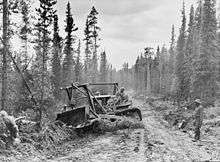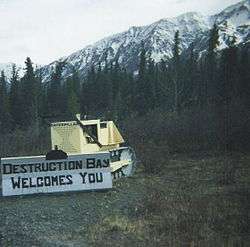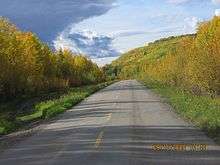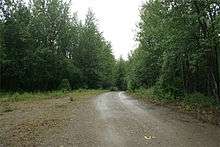Alaska Highway
| Alaska Highway | ||||||||||
|---|---|---|---|---|---|---|---|---|---|---|
|
Alaska State Route 2 Yukon Highway 1 British Columbia Highway 97 | ||||||||||
 | ||||||||||
| Route information | ||||||||||
| Length: |
2,232 km[1] (1,387 mi) (as of 2012) | |||||||||
| Existed: | 1942[2] – present | |||||||||
| Major junctions | ||||||||||
| South end: |
| |||||||||
|
| ||||||||||
| North end: |
| |||||||||
| Location | ||||||||||
| Major cities: | Fort St. John, BC, Fort Nelson, BC, Watson Lake, YT, Whitehorse, YT, Tok, AK, Delta Junction, AK | |||||||||
| Highway system | ||||||||||
|
British Columbia provincial highways Territorial highways in Yukon
| ||||||||||
The Alaska Highway (also known as the Alaskan Highway, Alaska-Canadian Highway, or ALCAN Highway) was constructed during World War II for the purpose of connecting the contiguous United States to Alaska across Canada. It begins at the junction with several Canadian highways in Dawson Creek, British Columbia, and runs to Delta Junction, Alaska, via Whitehorse, Yukon. Completed in 1942 at a length of approximately 1,700 miles (2,700 km), as of 2012 it is 1,387 mi (2,232 km) long. The difference in distance is due to constant reconstruction of the highway, which has rerouted and straightened out numerous sections. The highway was opened to the public in 1948.[2] Legendary over many decades for being a rough, challenging drive, the highway is now paved over its entire length.[1]
An informal system of historic mileposts developed over the years to denote major stopping points; Delta Junction, at the end of the highway, makes reference to its location at "Historic Milepost 1422."[1] It is at this point that the Alaska Highway meets the Richardson Highway, which continues 96 mi (155 km) to the city of Fairbanks. This is often regarded, though unofficially, as the northern portion of the Alaska Highway, with Fairbanks at Historic Milepost 1520.[1] Mileposts on this stretch of highway are measured from Valdez, rather than the Alaska Highway. The Alaska Highway is popularly (but unofficially) considered part of the Pan-American Highway, which extends south (despite its discontinuity in Panama) to Argentina.[3]
History
Construction
Proposals for a highway to Alaska originated in the 1920s. Thomas MacDonald, director of the U.S. Bureau of Public Roads, dreamed of an international highway spanning the United States and Canada. In order to promote the highway, Slim Williams originally traveled the proposed route by dogsled. Since much of the route would pass through Canada, support from the Canadian government was crucial. However, the Canadian government perceived no value in putting up the required funds to build the road, since the only part of Canada that would benefit was not more than a few thousand people in Yukon.
However, some route consideration was given. The preferred route would pass through the Rocky Mountain Trench from Prince George, British Columbia to Dawson City before turning west to Fairbanks, Alaska.
In 1929 the British Columbia government proposed a highway to Alaska to encourage economic development and tourism. American President Herbert Hoover appointed a board with American and three Canadian members to evaluate the idea. Its 1931 report supported the idea for economic reasons, but both American and Canadian members recognized that a highway would benefit the American military in Alaska; the Great Depression and the Canadian government's lack of support caused the project to not proceed. When the United States approached Canada again in February 1936, the Canadian government refused to commit to spending money on a road connecting the United States. The Canadians also worried about the military implications, fearing that in a war between Japan and North America, the United States would use the road to prevent Canadian neutrality. During a June 1936 visit to Canada, President Franklin D. Roosevelt told Prime Minister W. L. M. King that a highway to Alaska through Canada could be important in quickly reinforcing the American territory during a foreign crisis. Roosevelt became the first American to publicly discuss the military benefits of a highway in an August speech in Chautauqua, New York. He again mentioned the idea during King's visit to Washington in March 1937, suggesting that a $30 million highway would be helpful as part of a larger defense against Japan that included, the Americans hoped, a larger Canadian military presence on the Pacific coast. Roosevelt remained a supporter of the highway, telling Cordell Hull in August 1937 that he wanted a road built as soon as possible.[4]
The attack on Pearl Harbor and beginning of the Pacific Theater in World War II, coupled with Japanese threats to the west coast of North America and the Aleutian Islands, changed the priorities for both nations. On February 6, 1942 the construction of the Alaska Highway was approved by the United States Army and the project received the authorization from the U.S. Congress and Roosevelt to proceed five days later. Canada agreed to allow construction as long as the United States bore the full cost, and that the road and other facilities in Canada be turned over to Canadian authority after the war ended.


The official start of construction took place on March 8, 1942 after hundreds of pieces of construction equipment were moved on priority trains by the Northern Alberta Railways to the northeastern part of British Columbia near Mile 0 at Dawson Creek. Construction accelerated through the spring as the winter weather faded away and crews were able to work from both the northern and southern ends; they were spurred on after reports of the Japanese invasion of Kiska Island and Attu Island in the Aleutians. During construction the road was nicknamed the "oil can highway" by the work crews due to the large number of discarded oil cans and fuel drums that marked the road's progress.[5] On September 24, 1942 crews from both directions met at Mile 588 at what became named Contact Creek,[6] at the British Columbia-Yukon border at the 60th parallel; the entire route was completed October 28, 1942 with the northern linkup at Mile 1202, Beaver Creek, and the highway was dedicated on November 20, 1942 at Soldier's Summit.
The needs of war dictated the final route, intended to link the airfields of the Northwest Staging Route that conveyed lend-lease aircraft from the United States to the Soviet Union. Thus the long, impractical route over difficult terrain was chosen.
The road was originally built mostly by the U.S. Army Corps of Engineers as a supply route during World War II. In 1942, the Army Corps of Engineers assigned more than 10,000 men, about a third were black soldiers, members of three newly formed "Negro regiments".[7] There were four main thrusts in building the route: southeast from Delta Junction, Alaska toward a linkup at Beaver Creek, Yukon; north then west from Dawson Creek (an advance group started from Fort Nelson, British Columbia after traveling on winter roads on frozen marshland from railway stations on the Northern Alberta Railways); both east and west from Whitehorse after being ferried in via the White Pass and Yukon Route railway. The Army commandeered equipment of all kinds, including local riverboats, railway locomotives, and housing originally meant for use in southern California.
Although it was completed on October 28, 1942 and its completion was celebrated at Soldier's Summit on November 21 (and broadcast by radio, the exact outdoor temperature censored due to wartime concerns), the "highway" was not usable by general vehicles until 1943. Even then there were many steep grades, a poor surface, switchbacks to gain and descend hills, and few guardrails. Bridges, which progressed during 1942 from pontoon bridges to temporary log bridges, were replaced with steel bridges where necessary. A replica log bridge, the Canyon Creek bridge, can be seen at the Aishihik River crossing; the bridge was rebuilt in 1987 and refurbished in 2005 by the Yukon government as it is a popular tourist attraction. The easing of the Japanese invasion threat resulted in no more contracts being given to private contractors for upgrading of specific sections.
Some 100 miles (160 km) of route between Burwash Landing and Koidern, Yukon, became nearly impassable in May and June 1943, as the permafrost thawed, no longer protected by a layer of delicate vegetation. A corduroy road was built to restore the route, and corduroy still underlays old sections of highway in the area. Modern construction methods do not allow the permafrost to thaw, either by building a gravel berm on top or replacing the vegetation and soil immediately with gravel. The Burwash-Koidern section, however, is still a problem as the new highway built there in the late 1990s continues to experience frost heave.
Pincers on Japan and Look to the North both 1944 productions were National Film Board of Canada documentaries that depicted the construction of the Alaska Highway.[8][9]
Post war
The original agreement between Canada and the United States regarding construction of the highway stipulated that its Canadian portion be turned over to Canada six months after the end of the war.[10] This took place on April 1, 1946 when the U.S. Army transferred control of the road through Yukon and British Columbia to the Canadian Army, Northwest Highway System. The Alaskan section was completely paved during the 1960s; largely gravel even in 1981, the Canadian portion of the Alaska Highway is now completely paved, mostly with bituminous surface treatment.
The Milepost, an extensive guide book to the Alaska Highway and other highways in Alaska and Northwest Canada, was first published in 1949 and continues to be published annually as the foremost guide to traveling the highway.

The British Columbia government owns the first 82.6 miles (132.9 km) of the highway, the only portion paved during the late 1960s and 1970s. Public Works Canada manages the highway from Mile 82.6 (km 133) to Historic Mile 630. The Yukon government owns the highway from Historic Mile 630 to Historic Mile 1016 (from near Watson Lake to Haines Junction), and manages the remainder to the U.S. border at Historic Mile 1221. The State of Alaska owns the highway within that state (Mile 1221 to Mile 1422).
The Alaska Highway was built for military purposes and its route was not ideal for postwar development of northern Canada.[11] Rerouting in Canada has shortened the highway by approximately 35 miles (56 km) since 1947, mostly by eliminating winding sections and sometimes by bypassing residential areas. The historic milepost markings are therefore no longer accurate but are still important as local location references. Some old sections of the highway are still in use as local roads, while others are left to deteriorate and still others are plowed up. Four sections form local residential streets in Whitehorse and Fort Nelson, and others form country residential roadways outside of Whitehorse. Although Champagne, Yukon was bypassed in 2002, the old highway is still completely in service for that community until a new direct access road is built.
Rerouting continues, expected to continue in the Yukon through 2009, with the Haines Junction-Beaver Creek section covered by the Canada-U.S. Shakwak Agreement. The new Donjek River bridge was opened 26 September 2007, replacing a 1952 bridge. Under Shakwak, U.S. federal highway money is spent for work done by Canadian contractors who win tenders issued by the Yukon government. The Shakwak Project completed the Haines Highway upgrades in the 1980s between Haines Junction and the Alaska Panhandle, then funding was stalled by Congress for several years.
The Milepost shows the Canadian section of the highway now to be approximately 1,187 miles (1,910 km), but the first milepost inside Alaska is 1222. The actual length of the highway inside Alaska is no longer clear because rerouting, as in Canada, has shortened the route, but unlike Canada, mileposts in Alaska are not recalibrated. The BC and Yukon governments and Public Works Canada have recalibrated kilometre posts. The latest BC recalibration was carried out in 1990; using its end-point at the border at Historic Mile 630, the Yukon government has recalibrated in three stages: in 2002, from Mile 630 to the west end of the Champagne revision; in fall 2005, to a point just at the southeast shore of Kluane Lake, and in fall 2008, to the border with Alaska.
There are historical mileposts along the B.C. and Yukon sections of the highway, installed in 1992, that note specific locations, although the posts no longer represent accurate driving distance. There are 80 mileposts in B.C., 70 in Yukon and 16 in Alaska with a simple number marker of the original mile distance. There are 31 "historic signs" in B.C., 22 in Yukon and 5 in Alaska, identifying the significance of the location. There are 18 interpretive panels in B.C., 14 in Yukon and 5 in Alaska which give detailed text information at a turn-off parking area.
The portion of the Alaska Highway in Alaska is designated Alaska Route 2. In Yukon, it is Highway 1 and in British Columbia, Highway 97. The portion of the Alaska Highway in Alaska was planned to become part of the United States Numbered Highway System, and to be signed as part of U.S. Route 97. The portion of the Alaska Highway in Alaska is also unsigned Interstate A-1 and unsigned Interstate A-2.
Route markings

The Canadian section of the road was delineated with mileposts, based on the road as it was in 1947, until 1978, and over the years, reconstruction steadily shortened the distance between some of those mileposts. That year, metric signs were placed on the highway, and the mileposts were replaced with kilometre posts at the approximate locations of a historic mileage of equal value, e.g. km post 1000 was posted approximately where historical Mile 621 would have been posted.
Reconstruction continues to shorten the highway, but the kilometre posts, at 2-kilometre (1.2 mi) intervals, were recalibrated along the B.C. section of road in 1990 to reflect then-current driving distance. The section of highway covered by the 1990 recalibration has since been rendered shorter by further realignments, such as near Summit Pass and between Muncho Lake and Iron Creek.
.jpg)
Based on where those values left off, new Yukon kilometre posts were erected in fall 2002 between the B.C. border and the west end of the new bypass around Champagne, Yukon; in 2005, additional recalibrated posts continued from there to the east shore of Kluane Lake near Silver City; and in fall 2008, from Silver City to the boundary with Alaska. Old kilometre posts, based on the historic miles, remained on the highway, after the first two recalibrations, from those points around Kluane Lake to the Alaska border. The B.C. and Yukon sections also have a small number of historic mileposts, printed on oval-shaped signs, at locations of historic significance; these special signs were erected in 1992 on the occasion of the highway's 50th anniversary.
The Alaska portion of the highway is still marked by mileposts at 1-mile (1.6 km) intervals, although they no longer represent accurate driving distance, due to reconstruction.
.jpg)
The historic mileposts are still used by residents and businesses along the highway to refer to their location, and in some cases are also used as postal addresses.
Residents and travelers, and the government of the Yukon, do not use "east" and "west" to refer to direction of travel on the Yukon section, even though this is the predominant bearing of the Yukon portion of the highway; "north" and "south" are used, referring to the south (Dawson Creek) and north (Delta Junction) termini of the highway. This is an important consideration for travelers who may otherwise be confused, particularly when a westbound travel routes southwestward or even due south to circumvent a natural obstacle such as Kluane Lake.
Some B.C. sections west of Fort Nelson also route more east-to-west, with southwest bearings in some section; again, "north" is used in preference to "west".
Since 1949 The Milepost, an exhaustive guide to the Alaska Highway and all other routes through the region, has been published each year.
The community Wonowon, British Columbia is named by its location at mile 101, spoken "one-oh-one".
Route description
The pioneer road completed in 1942 was approximately 1,680 miles (2,700 km) from Dawson Creek to Delta Junction. The Army then turned the road over to the Public Roads Administration, which then began putting out section contracts to private road contractors to upgrade selected sections of the road. These sections were upgraded, with removal of excess bends and steep grades; often, a traveler could identify upgraded sections by seeing the telephone line along the PRA-approved route alignment. When the Japanese invasion threat eased, the PRA stopped putting out new contracts. Upon hand-off to Canada in 1946, the route was 1,422 miles (2,288 km) from Dawson Creek to Delta Junction.

The route follows a northwest then northward course from Dawson Creek to Fort Nelson. On October 16, 1957, a suspension bridge crossing the Peace River just south of Fort St. John collapsed. A new bridge was built a few years later. At Fort Nelson, the road turns west and crosses the Rocky Mountains, before resuming a westward course at Coal River. The highway crossed the Yukon-BC border nine times from Mile 590 to Mile 773, six of those crossings were from Mile 590 to Mile 596. After passing the south end of Kluane Lake, the highway follows a north-northwest course to the Alaska border, then northwest to the terminus at Delta Junction.
Postwar rebuilding has not shifted the highway more than 10 miles (16 km) from the original alignment, and in most cases, by less than 3 miles (4.8 km). It is not clear if it still crosses the Yukon-BC border six times from Mile 590 to Mile 596.
Major intersections
| Province | Location | km | mi | Destinations | Notes | |
|---|---|---|---|---|---|---|
| British Columbia | 869 | 540 | See British Columbia Highway 97#Major intersections for the intersections of the British Columbia Highway 97 segment | |||
| Yukon | Watson Lake | 965 | 560 | Southern terminus of Highway 4 | ||
| near Watson Lake | 986 | 613 | Northern terminus of Highway 37, To British Columbia Highway 37 | |||
| Johnsons Crossing | 1,275 | 792 | Southern terminus of Highway 6 | |||
| Jakes Crossing | 1,321 | 821 | Eastern terminus of Highway 8 | |||
| Carcross Cutoff | 1,383 | 859 | Southern terminus of concurrency with Highway 2 | |||
| Whitehorse | 1,415 | 879 | Northern terminus of concurrency with Highway 2 | |||
| Haines Junction | 1,555 | 966 | Northern terminus of Highway 3 | |||
| International border | 1,878 | 1,167 | See Alaska Route 2#Major intersections for the intersections along the Alaska Route 2 section | |||
1.000 mi = 1.609 km; 1.000 km = 0.621 mi
| ||||||
Bypassed road segments still in use

Fort Nelson
- Mile 301 to 308, now local residential feeder roads Wildflower Drive, Highland Road, Valleyview Drive
Whitehorse
- Mile 898, now local residential road just west of Yukon River Bridge
- Mile 920.3 to 922.5, now the southern and northern portions of Centennial Street; middle portion is Birch Street
- Mile 922.5 to 922.7, now a portion of Azure Road
- Mile 924, now a portion of Cousins Airfield Road
- Mile 925.5 to 926.9, now Parent Road (east end overlooks Alaska Highway/Klondike Highway junction)
- Mile 927.2 to 927.7, now Echo Valley Road
- Mile 928 to 928.3, now Jackson Road
- Mile 929 to 934, now Old Alaska Highway
- Mile 968, now entrance road to Mendenhall River Subdivision
Champagne-Aishihik traditional territory

- Mile 969 to 981, Champagne loop (bypassed in fall 2002 by 8.6-mile (13.8 km) revision)
- Mile 1016, Hume Street in Haines Junction including access to First Nation subdivision
Alaska
- Mile 1348,[12] one 2.5-mile (4.0 km) bypassed section of the original route, about 37 miles (60 km) southeast of Delta Junction, is listed on the National Register of Historic Places as "one of the few sections of the road in Alaska virtually unchanged." Located at 63°43′53″N 144°42′02″W / 63.731465°N 144.700526°W, the unpaved road is used by local residents to access Craig Lake,[13][14] and is signed as Craig Lake Trail.
Other former segments have deteriorated and are no longer usable. More recent construction projects have deliberately plowed up roadway to close it.
See also
- Inter-American Highway
- Kolyma Highway
- List of Yukon territorial highways
- Pan-American Highway
- Sign Post Forest
- Alcan - Beaver Creek Border Crossing
References
- 1 2 3 4 "Alaska Highway". The Milepost. Morris Visitor Publications. Retrieved January 8, 2012.
- 1 2 "Timeline: Alaska from Russian Colony to U.S. State". American Experience. WGBH/PBS. 2010. Retrieved January 8, 2012.
- ↑ "The Pan American Highway". How Stuff Works. Retrieved April 27, 2012.
- ↑ Perras, Galen Roger (1998). Franklin Roosevelt and the Origins of the Canadian-American Security Alliance, 1933-1945: Necessary, but Not Necessary Enough. Praeger. pp. 19–22, 34–36. ISBN 0-275-95500-1.
- ↑ "The Alcan Highway". Modern Marvels. Season 6. 2003.
- ↑ "Contact Creek". BC Geographical Names.
- ↑ "In Road-Building, Black Soldiers Defied Prejudice". The New York Times. July 23, 2012. Archived from the original on March 13, 2014. Retrieved September 10, 2015.
- ↑ Collection: 'Pincers on Japan'. NFB.ca. Retrieved: January 31, 2016.
- ↑ Film: 'Look to the North'." NFB.ca. Retrieved: January 31, 2016.
- ↑ Conn, Stetson; Fairchild, Byron. "Chapter XV, The United States and Canada: Elements of Wartime Collaboration". The Framework of Hemisphere Defense. United States Army in World War II: The Western Hemisphere. Washington, DC: Office of the Chief of Military History, Department of the Army. OCLC 1036066.
- ↑ Coates, K.; Morrison, W. R. (1991). "The American Rampant: Reflections on the Impact of United States Troops in Allied Countries during World War II". Journal of World History. 2 (2): 201–221. JSTOR 20078500.
- ↑ The Milepost (64th ed.). Morris Communications. 2012. p. 219. ISBN 978-189215429-3. ISSN 0361-1361.
- ↑ "NRHP listing for Alaska-Canada Military Highway". National Park Service. July 31, 2013. Archived from the original on July 7, 2014. Retrieved July 7, 2014.
- ↑ "NRHP nomination for Alaska-Canada Military Highway (Segment)" (PDF). National Park Service. July 31, 2013. Archived (PDF) from the original on July 7, 2014. Retrieved July 7, 2014.
External links
| Wikimedia Commons has media related to Alaska Highway. |
- Alaska Highway Construction on YouTube
- Alaska Highway — A Yukon perspective — From the Yukon Archives
- Alaska Highway Driving Facts — From the authors of the Milepost
- Bell's Alaska — mile by mile description of the Alaska Highway
-
 Alaska Highway travel guide from Wikivoyage
Alaska Highway travel guide from Wikivoyage - Building the Alaska Highway — Companion Website for the PBS program.
- Alcan-Highway.com — U.S. Army 95th Engineer Regiment (Colored) building the Alcan Highway
- Forgotten Facts About the African American Engineers Who Worked on the Alaska-Canada Highway - An article describing contributions made by the four African American regiments of the US Army Corps of Engineers that worked on the ALCAN Project
- Shortcut To Tokyo, September 1942 one of the earliest articles on the Alaskan Highway
- Many Wonders (but Few Amenities) on a Legendary Highway July 23, 2012 New York Times
- The short film ALASKA HIGHWAY (1944) is available for free download at the Internet Archive